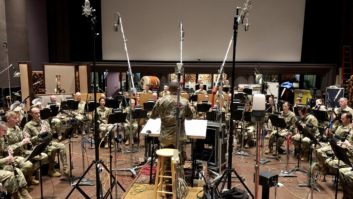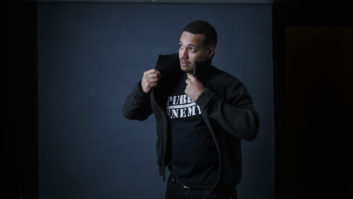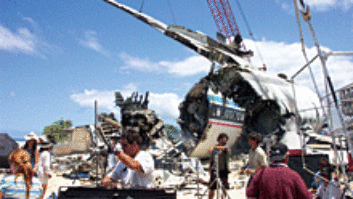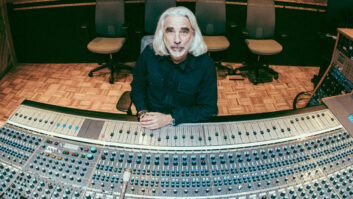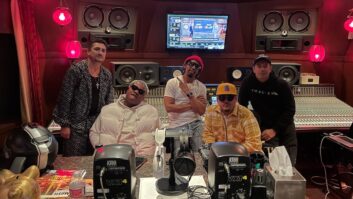In the way olden days — pre-Pet Sounds and Revolver — pre-production was a fairly well-defined process. It involved choosing material for a group or artist, hiring musicians to play (if there wasn’t a band) and then rehearsing the tunes until they could be cut live in a studio. And then, my, how things changed. When recording budgets seemed unlimited and the proliferation of studios meant there was always a room that could be locked out for months at a time, many artists started writing their songs in the studio and building tracks from the rhythm section up and working out their ideas through endless experimentation. And there are still artists who work that way — the rise of the sophisticated home studio has allowed that slow evolution of material to continue. But today, the industry is leaner and meaner: Record labels don’t like paying for major studio lockouts, and cost-cutting and efficiency are the name of the game. Now, more than ever before, it’s essential that artists — and the producers who work with them — keep an eye on the bottom line when they’re recording, and that often means devoting more time and energy to pre-production.
Every project is different, of course, and the nature of the music and the agreed-upon production style will dictate what and how much needs to be done in advance. Obviously, musicians who want to cut mostly live in the studio need to have their act together before the red light goes on. In genres that use pre-programmed beats and other computer-generated elements, the pre-production process might involve just a single engineer or producer or songwriter working in isolation and all but completing the track before a singer or rapper comes in. There’s no right or wrong way to do it, and the line between pre-production and actual tracking is blurring more each day.
Recently, we spoke with four producers working in different styles of music to find out about how they deal with pre-production issues.
GEORGE DUKE
With a career spanning four decades, keyboardist George Duke has appeared on literally hundreds of albums and produced dozens for a wide variety of R&B and jazz artists, including Marilyn Scott, Billy Cobham, Dianne Reeves, Dexter Gordon, Jeffrey Osborne and Dee Dee Bridgewater, to name just a few. His latest self-produced solo effort, In a Mellow Tone, finds him tackling a pleasing selection of original tunes, as well as classic and obscure standards.
“For my new album,” he says, “the first part of pre-production was finding musicians who understood the concept of what it was supposed to be. I chose a couple of musicians who had never worked together, but I’d worked with them separately — Terri Lyne Carrington on drums, Brian Bromberg on bass — both tremendous players. That was the nucleus of the record, along with Airto [Moreira] and Munyungo [Jackson] playing some percussion. The other thing was to find the songs. The producer’s job in the pre-production stage, whether it’s me or another artist, is to try to marry a song with the artist. There’s usually some give and take there about song choice and the way it could be arranged and how to approach it — simple or some orchestration, real instruments, electronic instruments.
“When I’m producing a singer, I might make synthesizer mock-ups to get the feel of it. I don’t get it sounding too involved because I don’t want the musicians when they hear it to feel like they’re obligated to play what I did on the synthesizer. But it gives a general direction and it allows the singer to actually rehearse with it ahead of time so they get a feel of what it might be. I didn’t do that on this album because I didn’t feel I needed to. But on the previous one, Duke, I did mock-ups of every song and they were pretty doggone detailed. In that case, I really did want the other musicians to get an idea of what I was looking for, so I sent it to them on an MP3 file and I also sent a chart, so by the time they arrived at the studio, they really knew the song.” In his studio, Duke has Pro Tools HD and a Euphonix console, “but I’m a Logic guy and I use GigaStudio, as well, so between those and my analog gear and [the] virtual instruments I have in my Mac, I’m pretty well pimped out here,” he says with a laugh.
“The other factor involved in pre-production I can’t ignore as a producer is budget, and that part is a drag for me,” Duke continues. “These days, with budgets being cut, I have to really keep an eye on costs. People say, ‘But you have your own studio.’ Well, that’s true, but this equipment costs money. I have a first engineer [Erik Zobler] and a second engineer to pay. I have a staff that works in the office that makes calls to musicians, keeps the contracts and does the bookkeeping. If I need to rent some outboard gear, if we’re recording it or mixing it somewhere else…meals, hotels if people are coming from out of town — all that goes into the fee and all that has to be down in writing for the record company before they agree to let you produce a record.”
KEITH CLARK
Keith Clark (aka Keith Clizark) came to production from a considerably different route. Born in Mississippi and raised in Long Beach, Calif., “I started out DJ’ing in high school for a hip hop radio station,” he says. “Later, I went to Long Beach City College, which has a top-rated music school, and I learned some theory there and I learned some technical things just from being around equipment and messing with it. I made my first record at the age of 17.”
Clark’s big break came when he hooked up with fellow Long Beach native Snoop Dogg. He’s done production for tracks on a few of Snoop’s albums, as well as discs by Tha Eastsidaz, Master P. and others. Like many rap producers, Clark takes the reins early in a production and devotes much time and energy to building tracks layer by layer.
“For me, pre-production starts with the concept of the song and it doesn’t really stop until I get to the last element that is to be applied, which is usually the vocals,” he offers. “For pre-production with a rapper, or any style that’s using a drum machine — based composition, the sound of the kick and snare is the foundation — that’s everything. If it doesn’t sound right, it’s not going to work. With rap in particular, the better your foundation is, the fewer elements you have to add to your composition. I have a studio at home and I’m using Pro Tools, and I have an [Akai] MPC 4000 [24-bit/96kHz sampler and sequencer] that I swear by. I’m also using GigaStudio with the live orchestra strings — that’s a really beautiful thing. And I’m using the [Yamaha] Motif ES [synth] and the Phantom, which is a brand-new module from Roland. It’s almost like the JV-2080s and 3080s, but it’s the next level. I primarily use that for acoustic sounds and string sounds.
“So I’m working with all of that and I’ll build the sounds of the beat, and then add as much ear candy as I need; I might have more than 40 tracks goin’ down,” he continues. “One thing I do that not many producers do anymore is put the kick and snare in stereo — it fattens up the sound a lot. Once I’ve got the track pretty much where I want it, I can take it to a bigger studio — like Larrabee [Los Angeles] — and prepare for vocals. I’ll also record live strings occasionally; I have a violin and cello player I work with. But even after the vocals get on it, you might hear something musically that will tie a vocal in better, and I’ll sometimes do that back in my studio. So, really, ‘pre-production’ doesn’t stop until it’s time to mix.”
Clark prides himself on coming up with original beats in pre-production and indeed he’s been so successful in that area that his work is represented on a pair of top-selling beat sample libraries from Big Fish Audio called Platinum Essentials. “I’ve owned every drum machine there is and I’ve kept those sounds,” he says. “But a lot of my signature beats have started with a live drummer. He’ll come in with a drum pad, and I’ll sample it and tweak it and layer it. I get a kick out of it when I hear one of my beats on another producer’s record,” he says with a chuckle.
Clark says that pre-production can take anywhere from a couple of days to a week or more, depending on the track. “So far, I’ve been fortunate in that most of the tracks I’ve done don’t get changed much later on,” he says. “I just try to think it all the way through and put on whatever needs to be there; if anything, they might want to take a sound out. That’s fine. [Laughs] “I’m cool with that. Just use the song!”
JIM JONSIN
Miami-based producer and mixer Jim Jonsin also started as a DJ, then got into production, “But I couldn’t really pay my bills early on, so I started engineering and did that for a number of years and learned everything about how to make my sound right — from the console to Pro Tools to outboard gear to MIDI,” Jonsin says. “I can do it all and that’s been important because if I’m trying to get a song onto an album, I want it to sound as good as I can make it. When you find producers who don’t understand [gear and technical things], they might have great ideas, but sometimes their sound isn’t really there and their demos are pretty rough. Those people don’t have a chance in hell with their demo. When they play his track against my track, it’s like a Casio to a Motif.”
Jonsin’s managed to get in a lot of doors since he broke into the biz in the late ’80s. He’s produced tracks for Trick Daddy, Twista, Pretty Ricky, Diddy, Ruben Studdard and Jamie Foxx, and mixed for many other artists. On the afternoon we spoke, he was mixing a track for Buckcherry and finishing a track for Trick Daddy.
“I don’t have any rules about what I’ll do in pre-production,” Jonsin says. “I’ll do everything from taking drum sounds and EQ’ing them — changing them — to laying keyboards in to get a base. Or maybe it’s a record that needs guitar, so we’ll do guitars from the keyboards until we can get a guitar player in; or a string section — I’ll put the strings down from the keyboard. For example, I did a Trick Daddy record with strings from the keyboard, but tomorrow night in Miami, I have these guys coming in — the Black Violins — to replay that part. I love the feel of live instruments.
“In general, the pre-production would be me programming from say, a Yamaha Motif or an MPC 2500, but then bringing it into the studio when the record is pretty much there and adding the live elements to it. During pre-production, we’ll also do a full mix. That doesn’t mean you won’t do a bigger mix later when you have everything, but I treat the pre-production mix seriously, too, because sometimes we’re trying to get in the door — you’re trying to [sell] the track and you want the person hearing it to understand what it can really be.
“These demos we do — you could really release a lot of them as records. And some people do pretty much release their demos.” Does Jonsin become so attached to a sound in the demo process that he chooses not to replace it later as intended? “Once in a while,” he replies. “Sometimes, the string sound on the keyboard is better than what you’d get out of just a couple of players because you can make it so lush that you’d need a large section to reproduce it and you might not have the time or the budget to get that. The Yamaha Motif has a real lush string section that sounds great. But guitars, never; bass, never; horns, sometimes I keep those [electronic versions]. Still, I always try to stay open.”
TIM PALMER
We close out our informal survey with a rocker: Working both in his native England and in the U.S., Tim Palmer has produced scads of great rock bands in a wide variety of styles, including Tears for Fears, Robert Plant, Gene Loves Jezebel, the Mission UK, Tin Machine, the Mighty Lemon Drops, H.I.M., Switchfoot and Ozzy Osbourne. He’s also done top-drawer mix work for the likes of U2, Faith Hill, Psychedelic Furs, The Cure and many others.
“What you need to achieve in pre-production is unique to every project,” he says from his home in L.A. “A rock band may wish to capture a live, organic feel, in which case, you need to perfect the arrangements and make sure everyone knows their parts. An electronic band may need to sort out any loops or keyboard sounds before entering the studio to save valuable dollars. When a musician is desperately trying to remember an arrangement, he is not likely to play to his best ability. If pre-production goes well and you get a good performance, then you are less likely to have to use any technology to fix it later.
“One thing that stands true for any pre-production is that it is a great time to get to know the band,” he continues. “It’s a great opportunity to make them feel relaxed and find out some information on what methods have worked, or not worked, for them before. It’s also the perfect time to figure out how they think and what they are looking for. Pre-production and the arrangement of a song are such an important part of the bigger picture. It’s better to get the song to feel right and be in the correct order than to spend too much time on mic choices for a hi-hat.”
However, Palmer also notes that “the line between pre-production and regular production has become increasingly blurred because of technology,” he says. “It’s true that sometimes band demos contain great sounds and performances, and when I hear something that is good I am happy because I will use it on the final master. The word ‘demo’ should be struck out of our vocabulary. The demo is dead. The reason for this is simple: The quality that can be achieved on a laptop or home studio is often better now than the best we could do in a major studio in years gone by. So, if something has that magic spark, then we can keep it and use it. I always say to bands, ‘Take the extra 15 minutes and make sure what you are recording is decent, as we may eventually use it.’ Always record everything and keep it.”
Palmer says that the high quality of Pro Tools and other hard disk recording systems has also changed the playing field. Now, pre-production rehearsals and writing sessions can be recorded and potentially used later as parts of a master take. “It’s obviously not essential, but it’s fair to say that today’s producer does need a good knowledge of Pro Tools and plug-ins,” he says. “It’s good to keep up if you can, because if you don’t, the bands can be faster than you are, as I’ve found on this recent Switchfoot album. Bands that have grown up with Pro Tools are so fast. It’s a weird feeling to have a band breathing down your neck and to know that they could do what you’re doing faster! Switchfoot has taught me a lot, and in return, I’ve tried to encourage them not to rely as much on the technology. I think this new album sounds better for being a little more human and quirky.
“Then, on [Osbourne’s] Down to Earth album, Ozzy was not too keen on hanging around a rehearsal room for hours on end, so I rehearsed with the band and recorded it all in my Pro Tools rig that I set up in the rehearsal room. This was very useful, as we could listen back and try simple overdub ideas before reaching the studio. When Ozzy would come in, I could play back the arrangements to him and he could try vocal ideas without having to deal with the huge volume, and at the same time, we could be fast, too.”
Blair Jackson is the senior editor of Mix.
